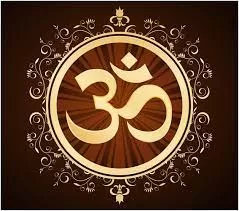One of the world’s oldest religions is Hinduism, and the most revered of all mantras is Om. People are becoming more and more conscious of the majestic essence of this religion in the modern world. Hindus believe in many gods and goddesses, but no one is known to have started the religion. The complexity and diversity of Indian culture are two of the main reasons why it is well known on a global scale. The symbolism in this culture is equally extensive.

The meaning of the sacred sound OM
Om is the universal sound. The vibratory sound of the force that drives all creation and emerges from Brahman, the unchanging, supreme reality, is the meaning of the Hindu symbol OM (aum). Hindu sages called rishis were able to see the essence of the universe when they meditated, and they found that this syllable contained that essence.
When you chant Om, you call on the supreme reality, or the all-powerful soul, as well as the music of creation in the universe. It invites knowledge of this spirituality and its embodiment.
Om, also known as Aum, is a bija, or seed mantra, that refers to Atman and Brahman, which are the whole universe, the ultimate reality, and cosmic knowledge. In a short spiritual explanation, the Om or Aum symbol is a syllable that connects you to the divine, the highest power, and the beginning of everything. It is the sound of the universe. The Upanishads contain the earliest written mention of this syllable.
What Does Om (Aum) Mean and Why Is It Used?
Om, also known as Aum, is thought to be a symbol of the Hindu Trimurti, in which the letters A, U, and M stand for Brahma, the creator, Vishnu, the sustainer, and Mahesh, the destroyer. These three gods govern the entire planet, according to Hindu mythology.
The Om Symbol: What Does It Infer?
Om is regarded as one of Hinduism’s most revered symbols. It is thought that “Aum” was the first sound to emerge from emptiness when the universe was first created. Additionally, it symbolizes the three different states of consciousness.
The design consists of a dot, a crescent, and a number of curves. The broad curve at the bottom represents the waking state. It is the most common way to be aware of the world, and it happens through the five senses. This curve might be seen as our public persona or as what we believe we ought to be. The higher curve represents the human mind’s unconscious condition, which has no desires.
Although it is concealed from us, this aspect of who we are is very much there. However, the intermediate curve, which lies between consciousness and unconsciousness, symbolizes the state of dreams. The crescent also stands for delusion, which stands in the way of our pursuit of ultimate happiness. The dot represents the “absolute” condition, which has attained the utmost degree of tranquility and peace and is neither outward nor inward.
All spiritual activity is aimed at achieving this. Aum’s visual depiction mimics the number 3 in appearance. This is a result of its extensive history with the number. Additionally, it stands for the unification of the three worlds—Earth, Heaven, and the Underworld.
Om—how do you say it?
The first word, A, is spoken as a drawn-out “awe.” You extend your throat as the sound begins at the back of your throat. Your chest and solar plexus will begin to vibrate.
The sound of the second syllable, U, is made by pronouncing an extended “oo,” which progressively moves forward along your upper palate. Your throat will start to shake.
The third syllable, M, is said by lightly touching your front teeth and saying “mmmm” for a long time. The top of your mouth will now begin to vibrate.
The deep hush of the infinite is the final syllable. You must blend your chant from the M with the deep silence, as wisdom arises from it. In a symbolic sense, the three letters stand for the three fundamental aspects of Shakti’s divine energy: creation, preservation, and liberation.
How can I use it in my work in a respectful manner?
Even if you are not traditionally Hindu, Buddhist, or Jain, you can still use the sound and sign of Om in your spiritual practice. However, it’s crucial to treat something so sacred with respect when using it. Here are two ways to use Om that respect its significance and history:
1. As an anthem
It’s meant to be said slowly: “It’s intended to raise your emotional and mental vibration.” Om can be said three times before yoga or while you’re meditating to help you focus.
2. Metaphorically
Feel free to include the Om symbol in your at-home meditation or prayer area if knowing about it and what it stands for inspires you to do so. Use it to remind yourself of your interconnectedness with the cosmos and the harmony of the mind, body, and spirit.
The Significance of repeating OM
By repeating Om, a person can help their mind and awareness grow beyond space and time. The yogic view of karma says that chanting Om can free you from your karmic obligations, as long as the person doing it does it right and knows what each syllable means. At that point, the unconscious mind becomes fully conscious.

The repetition of the Aum syllable, which is a symbol of all sacred mantras, can also help you get an understanding of your own intuition (within the yogic and Hindu traditions). When a practitioner understands and uses the sacredness of this syllable, they can become one with the divine or the ultimate reality.
Om is a potent mantra that can have a significant impact on one’s state of being. It is said that doing so can assist in bringing the mind, body, and spirit into balance, enhance consciousness, sharpen attention, and develop compassion.
The Advantages Of “Aum” Chanting
Chanting the holy word is thought to revitalize both the mind and the body by many yoga systems around the world. Since Aum discusses the three worlds and the three levels of consciousness, practicing in this world improves our capacity to function in all three states and worlds. It improves mental harmony for the subject. The subject will get closer to self-realization by repeating it.
Many Hindu mantras begin with the sound “Aum.” This is because chanting the heavenly sound clears the mind and has a purifying impact on the soul. When we pronounce “Aum” aloud, we shut off the outside world and concentrate solely on the sound. We can anchor ourselves but also unleash our brains in this way. The daily recitation of “Aum” aids in lowering stress and depression and improving focus.
When you chant Om, you invite creation’s ultimate reality into your awareness. You will be able to connect with your feelings and the subtle perceptions in your mind in this way.
Benefits of Chanting “AUM”
According to several studies, when we chant the Om, our heart and breathing rates synchronize!
Sound vibrations have a big effect on how a person feels mentally, emotionally, and physically.
All of our spiritual activities involve chanting Om, which brings our frequency into sync with the frequency of the universe.
The mind and breath then become in sync, which lets a person reach samadhi, a higher level of awareness.
One might have a clear and narrow concentration in this state of consciousness on the road to spiritual enlightenment and satisfaction.
Chanting slows down the mind’s ability to think and become absorbed in material things.
It also helps us keep a balanced autonomic nervous system, which helps us keep our own balance.
After that, you start to pay attention to the ideas and principles that surround you and your life.
Mantra chanting has a primary impact on our neurological system and mind. Your mind becomes calm and peaceful when you sing mantras.
The Scientific Relevance of Aum
When you say “Aum” at the beginning of every ritual, it means more than just a philosophical idea. Most people agree that sound can be a powerful healing tool that has big effects. Many techniques that are now accepted by the scientific community were known and used by the ancient yogis. One of them is mantra recitation.
Mantras are groups of sounds that have an effect by resonating with certain parts of the body. Different syllables vibrate at various sound frequencies, which causes them to resonate with particular organs and bodily parts. Human hearing has a frequency range of 20 Hz to 20 kHz. Aum vibrates at 432 Hz, a frequency that is relatively low for human hearing. This indicates that the sound wave is longer and vibrates at a slower frequency than a high-pitched sound at, say, 15 kHz. This has the physical effect of making the affected surface areas of these sound waves larger.

The Aum syllable addresses the entire human vocal apparatus on a physical level: we open the mouth (a)), move the lips closer together (u)), and finally close the mouth (m)). This thoroughly engages the larynx. The letters “A” and “U” resonate in the stomach and chest; “M” in the nasal cavity, skull, and brain. The energy from the abdomen is transferred to the brain by reciting Aum. We who regularly recite Aum before practicing see how it helps us relax and clear our minds.
“AUM” Om denotes Buddhism in other religions.
Buddhism makes use of “Aum.” This was most likely caused by Hinduism’s presence in its early stages. This holy phrase is used in Buddhism before mantras, the most well-known of which is “Om Mani Padme Hum.” The Dalai Lama has said that Aum is “made of three pure letters, A, U, and M.”
These represent both the impure exalted body, speech, and mind of an enlightened Buddha and the pure exalted body, speech, and mind of a practitioner living a normal, unenlightened life. In Buddhism, “Aum” stands for the body, speech, and mind rather than the ultimate reality.
It has been discovered that everything that happens spontaneously vibrates at 432 Hz, which is the same frequency as the mantra “Aum” when uttered. So, when we chant “Aum,” we become one with nature, and our minds soar to their highest level, where they can feel heavenly ecstasy. Because of this, we can see what “Aum” means and how it is used in different cultures.
The meaning and sound of the Om or Aum according to Buddhism
OM is a spiritual sound or mantra that can be heard and said as well as a visual sign. The syllable AUM is made up of the three sounds “A,” “U,” and “M.”
“A” is pronounced as an extended “awe.” This sound is the beginning, the moment the cosmos and everything in it were created. According to others, it represents the “awake or waking state.” According to Hindu belief, sound is connected to the Creator, Brahma. The upper chest vibrates as the sound travels from the abdomen. Keep your tongue in the bottom part of your mouth and part of your lips to look friendly.
“U” (a drawn-out “ooh” sound). This sound represents the steadiness that helps you move forward and the energy that keeps you and the world safe and alive. It is connected to Vishnu, the Preserver, a Hindu deity. From the first “A” sound, the sound moves forward by rolling along the upper palate and vibrating in the throat. The lips then start to move together.
“M” (the sound “mmmm”). Shiva is linked to this sound, which stands for the sound of closing in and the beginning of the end. Shiva is often called “the destroyer,” and he also has the power of climax, completion, and ending. We make the sound by bringing our lips together and moving our tongues to the roof of the mouth to produce a prolonged humming sound.
Disclaimer:
The author’s views are his or her own. The facts and opinions in the article have been taken from various articles and commentaries available in the online media and Eastside Writers does not take any responsibility or obligation for them.
Note: Contact our Writers at www.eastsidewriters.com for writing Blogs/Articles on any niche. We have experts in various domains from Technology to Finance and from Spirituality to Lifestyle and Entertainment.







Pingback: Explore 25 Lost And Forgotten Cities Of The World- Part 4 - Eastside Writers
Pingback: Is Narada A Sage, God, Trickster, Or God's Messenger- Discover The Truth - Eastside Writers